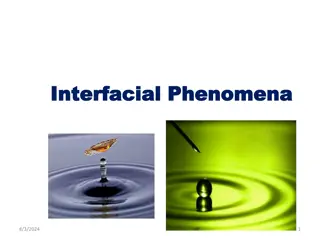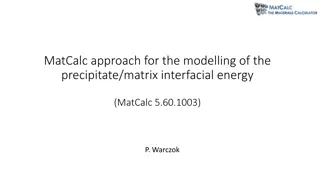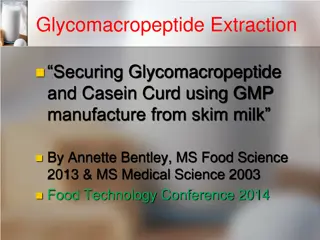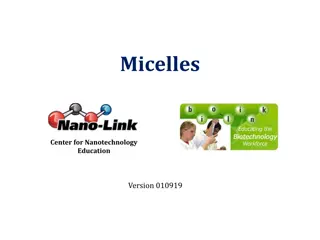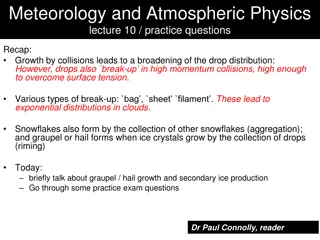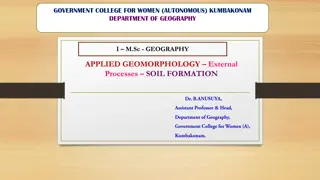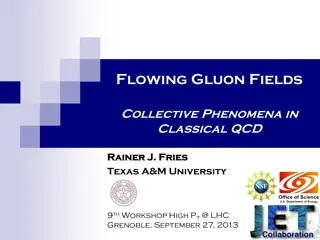Understanding Interfacial Phenomena and Micelle Formation
Interfacial phenomena play a crucial role in the formation of micelles in surfactant solutions, leading to a decrease in surface tension. The critical micelle concentration (CMC) marks the point where micelles first form in the solution. Factors like chain length and electrolytes impact CMC and micellar size. Additionally, adsorption at solid interfaces and wetting phenomena further enhance our understanding of interfacial dynamics.
Download Presentation

Please find below an Image/Link to download the presentation.
The content on the website is provided AS IS for your information and personal use only. It may not be sold, licensed, or shared on other websites without obtaining consent from the author. Download presentation by click this link. If you encounter any issues during the download, it is possible that the publisher has removed the file from their server.
E N D
Presentation Transcript
Interfacial Phenomena Interfacial Phenomena 9/12/2024 1
Micelle formation The surface tension of a surfactant solution decreases progressively concentration as more surfactant molecules enter the surface or interfacial layer. However, at a certain concentration saturated and an alternative means of shielding the hydrophobic group of the surfactant from the aqueous environment occurs through the formation of aggregates (usually spherical) of colloidal dimensions, called micelles. with increase of this layer becomes 9/12/2024 2
The concentration at which micelles first form in solution is termed the critical micelle concentration or CMC. 9/12/2024 3
Surface decrease increasing conc. Of surfactant CMC is reached , then constant tension with until become 9/12/2024 5
The CMC decreases with an increase in the length of the hydrophobic chain. The addition of electrolytes to ionic surfactants decreases the CMC and increases the micellar size.The effect is simply explained in terms of a reduction in the magnitude of the forces of repulsion between the charged head groups in the micelle, allowing the micelles to grow and also reducing the work required for their formation. 9/12/2024 6
Adsorption at solid interfaces Adsorption of materials at solid interfaces can take place from either an adjacent liquid or gas phase . The study of adsorption at gases arises in applications as removal of objectionable odors from rooms or food. The principle of solid liquid adsorption are used in decolorizing solutions , adsorption chromatography , detergency and wetting . 9/12/2024 7
Wetting Adsorption at solid surfaces is involved in the phenomena of wetting and detergency. When a liquid comes into contact with the solid , the forces of attraction between the liquid and the solid phases begin to play a significant role . In case of water and glass , attractive forces between the solid and liquid molecules are greater than the forces between molecules of liquid themselves. And so the liquid is able to wet the surface of the glass. 9/12/2024 8
The most important action of wetting agent is to lower the contact angle between the surface of and the wetting liquid The contact angle is the angle between a liquid droplet and the surface over which it spreads. The contact angle may be 0 , signifying complete wetting , or may be 180 at which wetting is insignificant. Or any value between these limits. 9/12/2024 9
9/12/2024 10
9/12/2024 11
9/12/2024 12
At equilibrium : Y s = Ys L+ y L Cos Which is known as young s equation The work of adhesion between the solid and the liquid is given : Wa = WsL = YL (1+Cos ) Spreading coefficient : S= YL(Cos -1) 9/12/2024 13
A contact angle is lower than 90 , the solid is called wettable A contact angle is wider than 90 , the solid is named non-wettable. A contact angle equal to zero indicates complete wettability. 9/12/2024 14
Wetting agent is a surfactant that when dissolved in water, lower the contact angle and aids in displacing the air phase at the surface and replacing it with a liquid phase. Examples on application of wetting in pharmacy and medicine include the displacement of air from the surface of the sulfur , charcoal and other powders for the purpose of dispersing these drugs in liquid vehicle ;displacement of dirt and debris by use of detergents in washing the wounds; and application of sprays and lotions to the surface of skin and mucous membranes. 9/12/2024 15
Example 15-14 Calculate spreading coefficient and work of adhesion of water on tablet surface to compare the influence of three tablet binders on wettability: Binder Y ( N/m) Cos Povidone 71.23 0.7455 Gelatin 71.23 0.7230 tapioca 71.23 0.7570 9/12/2024 16
Detergents Are surfactants that are used for the removal of dirt . Detergency is a complex process involving the removal of foreign matter form surfaces. The process includes : Initial wetting of dirt and of the surface to be cleaned . Deflocculation and suspension Emulsification or solubilization of the dirt particles . And sometimes foaming for washing away the particles. 9/12/2024 17
Detergents Detergents Detergents are surfactants used for removal of dirt. Detergency involves: Initial wetting of the dirt and the surface to be cleaned. Deflocculation and suspension, emulsification or solubilisation of the dirt particles Finally washing away the dirt. 9/12/2024 18
Foaming and Anti Foaming Foaming and Anti Foaming agents agents Foams are dispersion of a gas in a liquid (liquid foams as that formed by soaps and detergents ) or in a solid (solid foams as sponges ). Foaming agents Many Surfactants solutions promote the formation of foams and stabilize them, in pharmacy they are useful in toothpastes compositions. Anti Foaming agents They break foams and reduce frothing that may cause problems as in foaming of solubilized liquid preparations. 9/12/2024 19
Micellar Solubilization Micellar Solubilization Surfactant molecules accumulate in the interfaces between water and water insoluble compound. Their hydrocarbon chains penetrate the outermost layer of insoluble compound which combine with the water insoluble molecules. Micelles form around the molecules of the water insoluble compound inside the micelles cores and bring them into solution in an aqueous medium. This phenomenon is called micellar solubilization. The inverted micelles formed by oilsoluble surfactant which dissolves in a hydrocarbon solvent can solubilize water-soluble compound which is located in the center of the micelle, out of contact with the solvent. 9/12/2024 20


